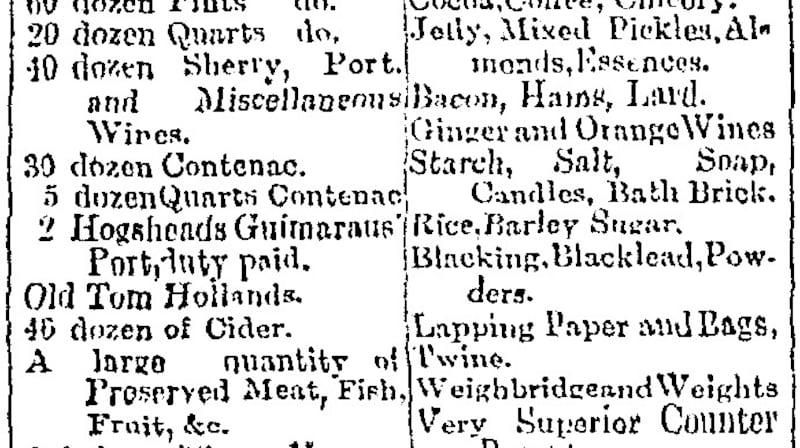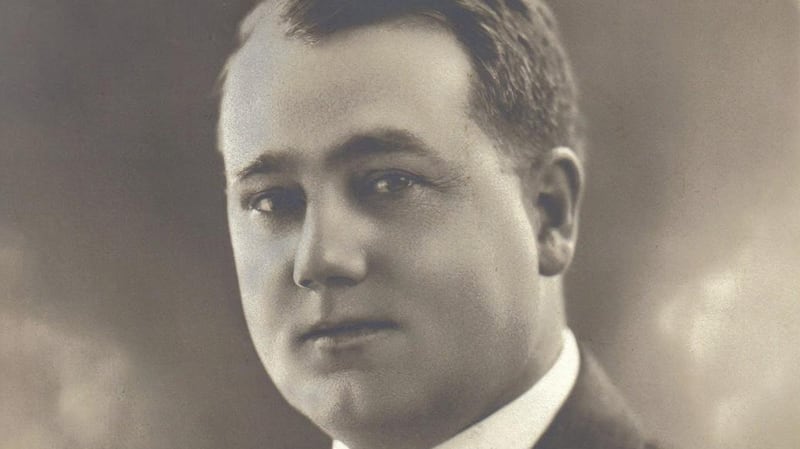Mary McEvoy Bailey emigrated to the US in 1886 with her young son, my grandfather Joseph, in tow. The sudden paralysis and later death of her husband Samuel at the age of 41 in the Monaghan Asylum in 1882 was the event that forced my grandfather’s emigration to the US as a child.
The goods from Samuel Bailey’s prosperous shop at 23 D’Olier Street in Dublin had already been auctioned down to the last pickle on January 5th, 1881, including more than 2,500 bottles of claret, port, sherry and other wines; spices, hams, jellies, and “an extremely useful horse” with delivery van and harness.

Joseph, who as an adult worked selling ladies hats and accessories, died of a heart attack in a Chicago elevator in 1937. Joseph’s passing left my father the man of the house at the age of 12. Being a teenaged boy during tough times, had to be difficult and Dad refused to talk about his past. I could never pry any information from him.

For Irish Catholics, my family is small. My mother had one sister. My father had a sister, and one brother who opted for the priesthood during the US Depression. I took a DNA test which told me that I carry 94 per cent Irish and British genes, which fits family lore.
Our family didn’t mingle much. We were clannish and kept to our Irish-American selves. Though we were raised Catholic, the single most important thing drilled into my head was that I should never forget where we came from, never forget I was Irish.
My parents, children of the Irish diaspora, carried massive regrets that their parents and grandparents had left Ireland under stressful circumstances. We were now living away from Ireland, but we clung to that identity. Proud Fenian ghosts watched over us.
Reconnecting
My sister Maureen and I undertook our journey to reconnect with Ireland about 17 years ago, well before Brexit. We were hampered by poor records, and by the expense of research. My dad’s Chicago birth certificate lists his name only as “Baily”. No first name and a misspelled last name.
When the whole Brexit story broke, it put me into a mild panic. I feared that Ireland might change the rules about citizenship before I could put the pieces of my particular puzzle in place.
Indeed, once the Brexit avalanche of foreign birth registry applications began, Ireland pulled applications in from consulates in the US to offices in St Stephen’s Green. We persevered and finally gathered the documentation to register our foreign births.
When I held the letter of congratulations from St Stephen’s Green, I cried. It is hard for me to express what that recognition meant. Validation, reconnection, perhaps even the righting of very old wrongs.
Having never lived in the Republic, I make no claim to being Irish Irish. But I am immersed in Irish history and current events. I read. I listen.
Having never lived in the Republic, I make no claim to being Irish Irish. My attempts at learning the language are sad and funny at the same time. But I am immersed in Irish history and current events. I read. I listen. I'm a Patreon supporter of the Irish Passport podcast, as well as Fin Dwyer's Irish History podcast.
Heritage
We have an active Irish Heritage club in Seattle - irishclub.org - that gives various opportunities to connect. I've shaken hands with the Irish consul Robert O'Driscoll; I've heard the Mayor of Galway speak; I've been to a lecture by Dr Micheline Sheehy-Skeffington.
I've been to Ireland once, and plan to return next year for a longer visit. I've connected with researchers on www.irelandxo.com who provided the advertisement of the auction of my great-grandfather's shop in Dublin following his illness and death.
On my right shoulder I now have a tattoo. It’s a familiar image - the triskelion carved into the interior of Newgrange some 5,000 years ago. For me this art means several things. It represents Ireland looking over my shoulder all my life. It represents the burden of carrying Irish identity while living away from it. It’s an acknowledgement that my ancestry goes way, way back, mostly on one green island.
In a recent article in The Irish Times, Are Irish passport holders in Britain becoming 'more Irish'? Dr Marc Scully wondered if for some people getting an Irish passport is "simply the formalisation of an already held identity". In my case, the answer is most definitely yes.
Seán Bailey retired from the US Postal Service in 2015. He currently lives with his husband, John Knutson, in Kent, Washington, a suburb of Seattle.




















